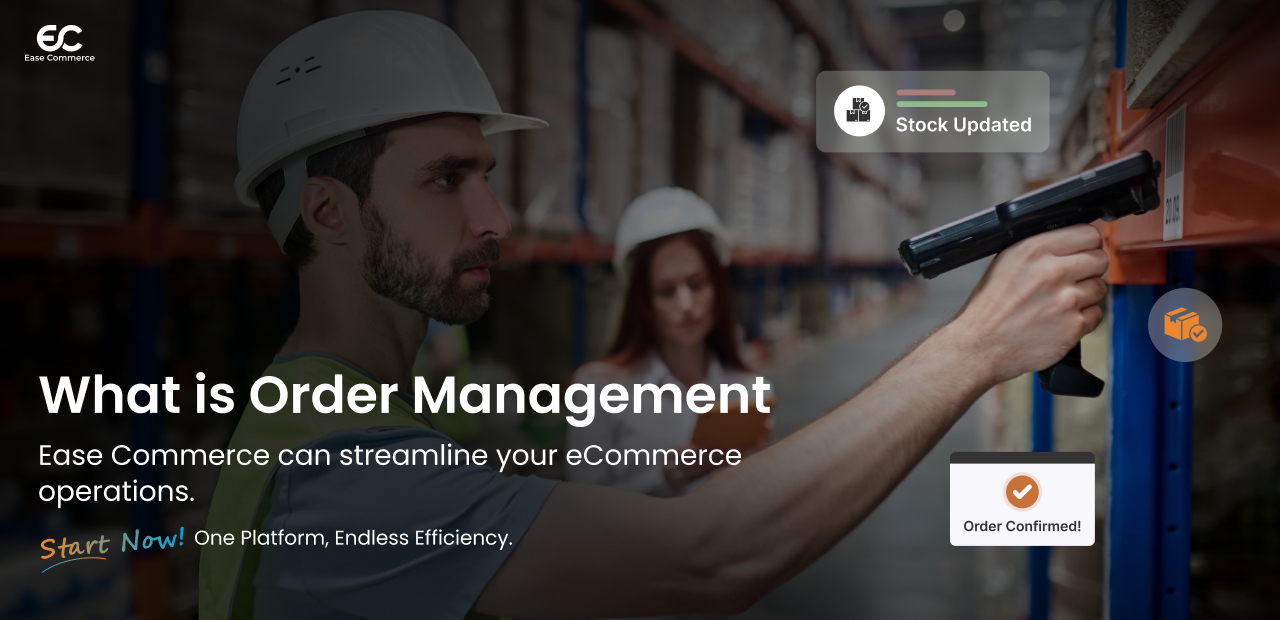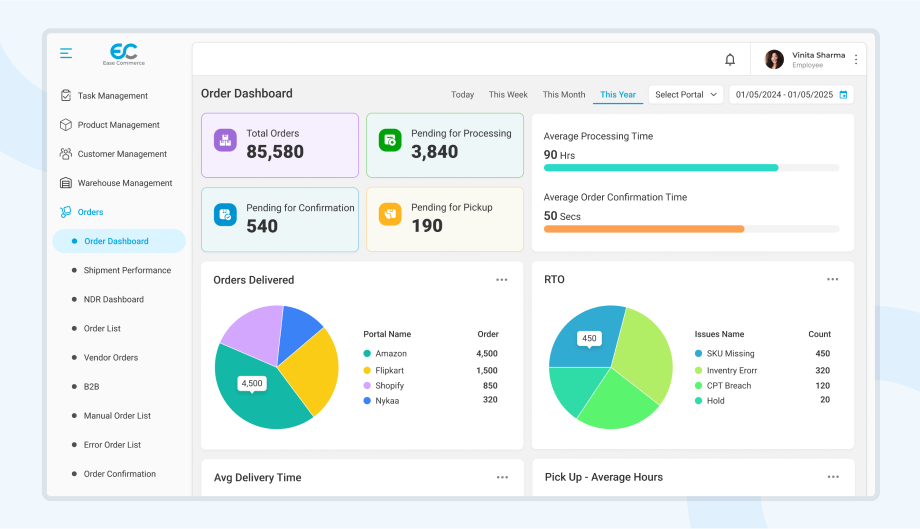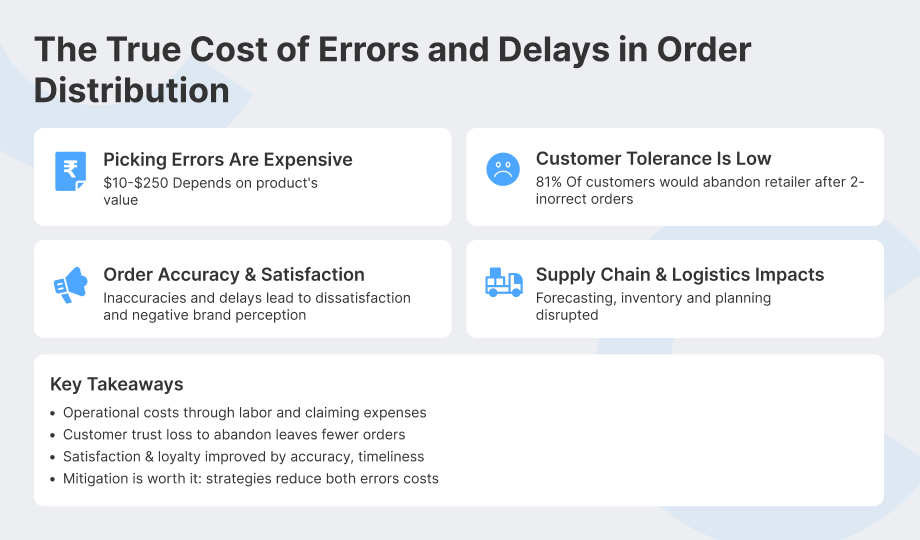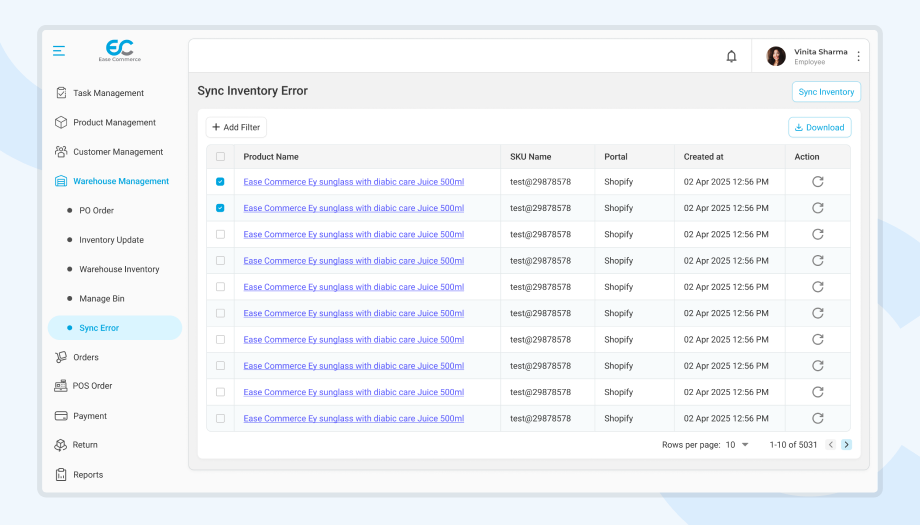A Guide to Understanding Order Management in eCommerce
By: Maitri Bhardwaj
Aug 11, 2025

Table of Contents
- So, what exactly is order management?
- Traditional vs. Modern Order Management Systems
- Primary Components of an Order Management System
- Benefits of Effective Order Management
- Challenges in Order Management Across Various Platforms
- Strategies for Integrating Order Management Systems with Various Sales Platforms
- Tips for Maintaining Consistency in Customer Experience Across All Channels
- Conclusion
- Ready to Transform Your Order Management Experience?
Featured Posts
- Ease Commerce Becomes India’s Official Amazon MCF Partner: Faster Fulfillment, Zero Chaos
- How the Right Customer Support Solution Boosts FCR
- What Is Returns Management for Multi-Channel Sellers
- Choosing the Right Task Management Software for Sellers
- How to Tell If Your E-Commerce Business Is Ready for a Warehouse Management System
When usually asked, “What is order management?” most of the online sellers will sum it up as the process that runs in the background, which results in the customers receiving their orders.
Globally, the multi-channel order management market is expected to grow in size by US$ 4.2 billion by 2027.
Multi-channel retail can be a bit tricky to deal with, in the first place, but there are always other sellers standing with you in the crowd. 74% of online retailers report order management as their top challenge, with a multitude of missed opportunities and customer dissatisfaction.
For you to make it big in the e-commerce world, we have just the guide for you. Whether you’re a retailer juggling multiple marketplaces, a distributor managing your supply chain, or a third-party logistics provider trying to minimize the hours spent and maximize output, Order management is crucial to surviving in the domain of buying and selling.
So, what exactly is order management?
Let’s be real, order management isn’t just about getting a confirmation email out. It’s the whole chain of events from the second someone clicks “Buy Now” to the moment the package reaches their door (or gets returned).
And when that chain isn’t tight, cracks start to show.
- Your operations team wastes hours figuring out which warehouse has the stock
- Orders get delayed because of manual routing mistakes
- Couriers show up late or not at all because pickup assignments were missed
- Customers open support tickets asking, “Where’s my order?” for something that should’ve arrived yesterday
- And nearly 1 in 4 returns don’t get processed right because no one’s tracking what came back and what didn’t
If you're selling on multiple platforms such as Amazon, Flipkart, your D2C site, maybe even Instagram DMs, you know the drill. One marketplace says "Out for Delivery," another shows "Pending Dispatch," and your own backend has no clue what’s happening.
Here’s what that costs you:
- Burned hours in coordination
- Rising return-to-origin (RTO) rates
- Missed SLA penalties
- And worst of all, lost trust from repeat buyers
In fact, businesses dealing with multi-channel fulfillment lose 5–15% of potential revenue to order management gaps alone. Not because their product isn’t good, but because their process is broken.
And if you’re scaling without fixing this, you’re just scaling the chaos.
Traditional vs. Modern Order Management Systems
Traditional order management systems had a lot of challenges to start with. They often involved manual tracking and were standalone systems which were typically isolated and required a large source of manpower to update and maintain. Since they were always prone to human error, the orders usually had discrepancies and faced delayed order processing, which led to overall lag in communication across departments.
As opposed to this, the modern order management solutions automate and streamline these processes using modern technology. Many advanced OMS for indian sellers offer real-time visibility into inventory levels, order statuses, and customer interactions across all the sales channels using their highly integrated and automated solutions. Particularly helpful for brand distributors, retailers, and third-party logistics providers, this integration is useful to all those who are managing product lines through multiple marketplaces.
The best thing about an order management system is its ability to update the inventory levels as soon as a sale is made, ensuring that the data is always consistent in real-time or near real-time. It helps in reducing the overselling or stockouts easily, which are a major concern in high-volume, multi-channel sales environments.
Furthermore, modern systems, like Ease Commerce, provide detailed analytics and reporting features that help businesses anticipate demand trends, optimize inventory, and enhance forecasting accuracy. Such insights are invaluable for making strategic decisions that align with business goals and customer expectations.

The Modern OMS You Actually Need Exists.
Real-time inventory, automated returns, and lightning-fast confirmations. Ease Commerce gives you all that, without the overhead.
Primary Components of an Order Management System
An Order Management System is important for the seamless operation of Indian eCommerce businesses, allowing for efficient handling of various crucial aspects from inventory to customer returns. Here, we break down the core components that constitute a robust OMS:
Inventory Management
Inventory management in an OMS handles the real-time tracking and synchronization of stock levels across the available sales channels. It ensures that inventory data is updated instantly when items are sold, returned, or restocked.
This component is essential for maintaining accurate stock levels, preventing overstocking or stockouts, which can lead to lost sales or excess capital tied up in inventory. Real-time data helps businesses make informed purchasing and marketing decisions, optimizing their inventory turnover rates.
Order Processing
This facet of an OMS automates the entire order lifecycle from the moment an order is received until it is fulfilled. Automation includes order entry, validation, fraud checks, payment processing, and order routing to the appropriate fulfillment center.
Automated order processing reduces human error, speeds up the order cycle, and pumps up customer satisfaction while simultaneously improving the delivery times. It allows businesses to handle higher volumes of orders efficiently, scaling as sales grow without the equally proportional increase in errors and delays.
Shipping and Logistics
Shipping and logistics integration in an OMS involves coordinating with various carriers and logistics providers to manage the dispatch, shipping, and delivery of orders. This component often includes tools for label creation, shipment tracking, and delivery updates.
Effective shipping and logistics management ensures that products are delivered to customers in a timely and cost-effective manner. Integration with carriers and tracking systems enhances transparency, allowing customers and businesses to monitor shipments in real-time, reducing the incidence of lost shipments and improving customer trust.
Returns Management
Returns management helps optimize the process of handling returned goods. This includes initiating returns, processing refunds, restocking items, and managing reverse logistics.
A streamlined returns process enhances customer satisfaction by making it easier for customers to return products. Efficient returns management also helps in quickly reintegrating returned goods into inventory, minimizing losses, and maintaining accurate stock levels.
Discover how Ease Commerce streamlines return processing and resupply workflows to cut down on time, errors, and customer complaints.
Benefits of Effective Order Management
Effective order management systems act as a vital infrastructure for managing e-commerce operations efficiently. These systems enhance several facets of business operations, notably customer experience, inventory control, and financial health.
Benefit #1: Enhancing Customer Experience Through Efficient Order Management
- Faster Processing: Even a small delay after order placement can snowball into a much bigger issue. A missed courier pickup leads to a postponed dispatch. That delay pushes delivery beyond the promised date. And when that happens, customers cancel, don’t accept the package, or file complaints, leading to Return to Origin (RTO).
Every RTO not only eats into your logistics cost but also hurts your platform ratings, trust signals, and overall customer experience. For indian brands growing online and selling across multiple marketplaces, these delays quietly erode profit margins and long-term loyalty.
- Accurate Delivery Predictions: One of the biggest cracks in the e-commerce experience is definitely unreliable delivery timelines.
Inconsistent courier performance, lack of warehouse coordination, and outdated order syncing often result in delivery estimates that aren’t just off; they’re misleading. Your website or marketplace says “Delivers by Tuesday,” but the package arrives on Thursday. Or worse, it gets stuck in transit with zero visibility.
This mismatch frustrates customers and damages brand credibility in the long run. For the brand, it increases support queries and pushes first-time buyers away for good. In the Indian market, where speed and reliability are often key differentiators, poor delivery accuracy can quietly kill growth.
A major Surat-based retailer revamped their OMS with Ease Commerce, which resulted in a 50% reduction in order fulfillment times. The new system provided customers with real-time updates about their order status, leading to a noticeable improvement in customer satisfaction ratings.

Benefit #2: Inventory Control: Mitigating Overstocks and Stockouts
- Reduced Overstocks and Stockouts: An efficient OMS is nothing but a software that maintains optimal inventory levels by synchronizing stock data across all sales channels or payment portals, and warehouses in real-time. With this kind of synchronization, OMS helps prevent overstocking or running out of stock, making sure that capital is not tied up in excess inventory and sales opportunities are not lost. Maintaining balanced inventory levels is critical for minimizing holding costs and maximizing the availability of products for timely sales.
Suppose a boutique clothing retailer implemented a new OMS that featured enhanced inventory tracking and forecasting tools. This upgrade led to a 30% reduction in overstock costs and a 25% decrease in instances of stockouts during peak shopping seasons, boosting overall sales and customer satisfaction.
Benefit #3: Improving Financial Health with Order Management Systems
- Improved Cash Flow: In eCommerce, your cash flow isn’t tied to how many orders you get, but rather to how quickly those orders get shipped, delivered, and cleared for settlement.
Most Indian businesses wait anywhere between 7 to 15 days for marketplace payouts. That wait gets longer if there are delays, return windows, or reconciliation mismatches. If you're overselling, missing invoices, or chasing couriers for updates, your revenue gets stuck.
Ease Commerce fixes that at the root.
Here’s how:
- Order and return sync across all platforms ensures every sale gets captured, processed, and closed without manual follow-ups.
- Inventory logic prevents overselling, so you don’t lose prepaid orders due to cancellations or stockouts.
- Automated reconciliation workflows mean you don’t need to wait for month-end reports to realize a payment got stuck.
It results in orders getting processed and settled faster, returns no longer block your revenue flow, and finance teams can track and recover stuck payments in real time.
In this manner, you’re not just reducing friction but rather shrinking your cash cycle. That means more liquidity, better capital planning, and fewer surprises on your balance sheet.
- Reduced Handling Costs: Automation reduces the need for manual intervention in order processing, inventory management, and customer service, leading to lower labor costs and operational expenditures.
An electronics wholesaler integrated their order management with their accounting and CRM systems. This integration provided a unified view of their financial operations, resulting in a 20% improvement in cash flow and a 15% reduction in operational costs within the first year.

Challenges in Order Management Across Various Platforms
Let’s explore the various challenges faced by businesses and how an order management solution plays a vital role in addressing these issues.
Inventory Management Discrepancies
One of the primary challenges in multi-platform order management is maintaining accurate inventory levels across all channels. Discrepancies in inventory can lead to issues such as overselling or stockouts, which damage customer trust and satisfaction. An effective order management system ensures real-time tracking and synchronization of inventory, reducing the risk of such discrepancies.

Complex Customer Data Integration
Another significant challenge is the integration of customer data across different platforms. Each platform may collect and store customer data differently, making it difficult to create a unified customer profile. An omnichannel order management solution facilitates the aggregation of this data, providing a comprehensive view of customer behaviors and preferences, which is crucial for personalizing the customer experience and enhancing engagement.
Logistical Challenges
Handling logistics across multiple platforms can be particularly challenging, especially when dealing with different shipping methods, costs, and times. An integrated order management system helps streamline these processes by offering centralized control and visibility over all logistics operations. This integration ensures more accurate delivery predictions and more efficient route and transportation planning.
Regulatory Compliance
As businesses expand across multiple platforms and geographical boundaries, they must comply with various regional, national, and international regulations. An effective order management solution helps ensure compliance by incorporating regulatory standards into every aspect of the order process, from data security to environmental regulations regarding shipping and packaging.
Coordination Between Multiple Departments
Effective communication and coordination between various departments (sales, inventory management, shipping, customer service) become more complex in a multi-platform environment. An omnichannel order management system can bridge these gaps by providing a single, unified platform where all relevant information is accessible to every department in real-time, enhancing collaboration and efficiency.
Technological Integration Issues
Integrating new order management solutions with existing IT infrastructure can pose significant challenges, particularly in terms of software compatibility and data migration. Selecting an order management system that can seamlessly integrate with existing platforms without disrupting current operations is crucial for a smooth transition and ongoing operations.
Strategies for Integrating Order Management Systems with Various Sales Platforms
- Centralized Data Hub: Implement an order management system that serves as a centralized platform for all orders and inventory data. This hub should integrate seamlessly with all marketplace APIs to ensure real-time data accuracy.
- Automated Inventory Updates: Utilize an order management solution that offers automated inventory adjustments every time a sale is made or stock is replenished, reducing the risk of inventory errors across channels.
- Unified Customer View: An effective order management system should provide a holistic view of customer interactions across all channels, enabling personalized service and better customer relationship management.
- Omnichannel Order Management: This approach ensures that regardless of how or where a customer makes a purchase, the service level and experience are consistent. Omnichannel order management integrates offline and online sales channels, providing a cohesive experience that enhances customer satisfaction and loyalty.
Tips for Maintaining Consistency in Customer Experience Across All Channels
- Consistent Brand Messaging: Ensure that all communication, whether on your website, marketplaces, or physical stores, maintains consistent branding and messaging.
- Standardized Fulfillment Processes: Establish standardized processes for order processing, delivery, and returns across all channels to ensure a predictable and reliable customer experience.
- Regular Training for Customer Service: Regularly train customer service teams on all aspects of the order management system and customer engagement strategies to ensure they provide uniform information and support.
Conclusion
Why Choose Ease Commerce for Order Management?
Choosing the right order management system is at the very crux for e-commerce businesses aiming to streamline their operations, better their customer satisfaction, and increase overall efficiency. Ease Commerce offers a robust order management solution tailored to meet the unique needs of modern online retailers. Here’s a detailed breakdown of why Ease Commerce stands out as the optimal choice for managing orders across various platforms.
1. Integrated Multichannel Capabilities
Ease Commerce excels in providing a seamless integration across all sales channels, from online marketplaces to brick-and-mortar stores. This integration is vital for businesses that operate on multiple platforms, as it ensures consistent and accurate order processing, inventory management, and customer data across all points of sale.
- Benefits:
- Unified inventory updates prevent overstocking or stockouts.
- Consistent customer experience across all channels enhances brand loyalty.
2. Real-Time Inventory Management
One of the core strengths of Ease Commerce is its real-time inventory management system. This feature allows businesses to track stock levels accurately and update inventory across all channels instantly when a sale is made or stock is received. It eliminates the common discrepancies that can lead to customer dissatisfaction and lost sales.
- Benefits:
- Minimized risk of overselling and understocking.
- Enhanced ability to make informed decisions based on real-time data.
3. Advanced Analytics and Reporting
Ease Commerce provides comprehensive analytics and reporting tools that help businesses gain valuable insights into their operations. These tools analyze data across various metrics, including sales performance, and inventory turnover, offering actionable insights to drive growth and efficiency.
- Benefits:
- Data-driven decision making improves operational efficiency and market responsiveness.
- Customizable reports tailored to specific business needs and goals.
4. Automated Order Processing
Automation is at the heart of the Ease Commerce order management system. From order entry to fulfillment, each step is automated to minimize manual input and error. This automation speeds up the entire order process, enhancing customer satisfaction through faster delivery times.
- Benefits:
- Reduced labor costs and human error.
- Increased order processing speed and accuracy.
5. Flexible and Scalable Solutions
As businesses grow, their order management needs evolve. Ease Commerce is designed to be both flexible and scalable, accommodating the changing needs of businesses as they expand. Whether it’s adding new sales channels, handling increased order volumes, or integrating new logistics partners, Ease Commerce adapts to support growth.
- Benefits:
- Supports business expansion without the need for significant system changes.
- Scales easily to handle peak periods like holiday sales.
6. Exceptional Customer Support
Ease Commerce prides itself on providing top-notch customer support. Their team of experts is available to assist with any issues that arise, ensuring minimal downtime and quick resolutions. This support is crucial for maintaining continuous business operations, especially in the fast-paced world of e-commerce.
- Benefits:
- Dedicated support reduces potential disruptions.
- Training and resources are provided to ensure users can fully leverage the system’s capabilities.
7. Compliance and Security
Compliance with industry standards and data security is all too important for indian as well as global eCommerce businesses. Ease Commerce ensures that all transactions and data handling meet the necessary regulatory requirements, providing peace of mind and protecting against potential legal issues.
- Benefits:
- Enhanced security features protect customer and business data.
- Compliance with e-commerce regulations reduces the risk of penalties.
Ready to Transform Your Order Management Experience?
Take the first step towards streamlining your eCommerce operations and enhancing customer satisfaction with Ease Commerce. Join the lines of countless successful businesses that have already elevated their order management processes. Contact us today for a personalized demo and discover how Ease Commerce can tailor its solutions to meet your unique business needs.
Let's build a future where your order management is as efficient and customer-focused as your brand deserves.
